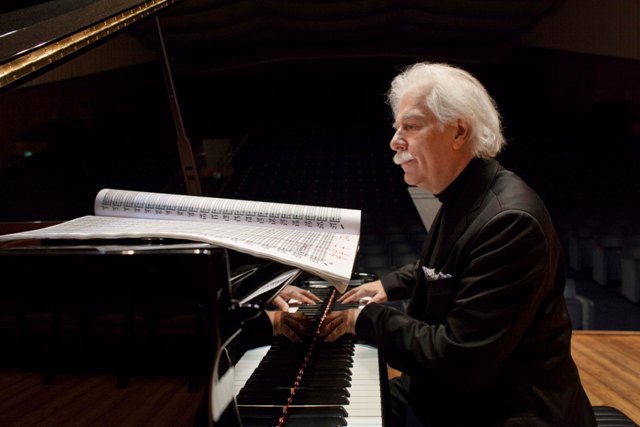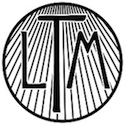Avant-Garde Art \ Franco Casavola \ Futurlieder [LTMCD 2454]
Futurlieder is an anthology by Italian Futurist composer Franco Casavola. Invited to join the Futurist movement by F.T. Marinetti in 1922, Casavola wrote a number of scores for theatre productions, including the mechanical ballets Anihccam del 3000 and Fantasia Meccanica. He also produced a number of essays and manifestos on future music, and even a Futurist novel, Introduction to Madness. Casavola broke with Futurism in 1927 and afterwards scored only movies.
The composer claimed - falsely - to have destroyed all his Futurist scores in 1927. Futurlieder gathers together short pieces such as Dance of the Monkeys (Hop Frog), Zoological Foxtrot, Epileptic Cabaret and Campari, the latter one of the first published advertising jingles. In addition the 66 minute album includes longer song cycles such as Tankas, Liriche, La Sera and Gioielleria Notturna, all of them avowedly Modernist in character, and include settings of lyrics by the poet Gabriele d'Annunzio.
All 28 tracks on Futurlieder were recorded by Italian duo Daniele Lombardi (piano) and Susanna Rigacci (soprano) between 1994 and 2004. The set was produced by Carlo Piccardi for Radio Svizzera/Rete-Due, with whom this project is a co-production.
The cover art is based on a 1932 design by Fortunato Depero.
Tracklist:
1. La Canzone di Uriele
2. Campari
3. La Danza della Scimmie
4. Fox-Trot Zoologico
5. Tango Viola de 'Cabaret Epilettico'
6. Tankas Pt. 1
7. Tankas Pt. 2
8. Tankas Pt. 3
9. Tankas Pt. 4
10. Tankas Pt. 5
11. Tankas Pt. 6
12. Preludio a 'Prigionieri'
13. Quatrain
14. Liriche Pt. 1
15. Liriche Pt. 2
16. Liriche Pt. 3
17. La Sera Pt. 1
18. La Sera Pt. 2
19. La Sera Pt. 3
20. Entro I Boschi Alto e Soli
21. Allegro
22. Come Sorge la Luna
23. Muoio de Sete
24. Gioielleria Notturna Pt. 1
25. Gioielleria Notturna Pt. 2
26. Fides
26. Leila
28. Notte
Available on CD and digital (MP3 or FLAC). To order please first select correct shipping option (UK, Europe or Rest of World) and click on Add To Cart cart button below cover image. Digital copies are delivered to customers via link sent by email.

Daniele Lombardi was born in Florence, Italy. Since 1969 he has established an international reputation both through his own compositions, and with an avant-garde repertoire exploring Futurism and other modernist works. His collection Musica Futurista won an Italian Recording Critics Award in 1987, and he has edited the tri-monthly contemporary music magazine La Musica. When not writing and performing he teaches piano at the Conservatoire G. Verdi in Milan.
![Futurlieder [LTMCD 2454]](../images/ltmcd2454.jpg)
Sleevenote:
In a letter dated 1 October 1922, Filippo Tommaso Marinetti wrote to inform composer Franco Casavola that: "I've listened to Tankas, Quatrain, Gioielleria Notturna, Leila and Muoio di sete on the piano. They reveal to me a strong and original musical genius. We Futurists would be pleased if you would join our fight against obsolete ideas."
Casavola (who had studied at the Rome Conservatory) accepted this invitation with alacrity, and formally joined the radical Italian art movement. Thereafter he began to compose new pieces under the influence of earlier manifestos written by Marinetti, and later specific tracts on Futurist Music produced by Francesco Balilla Pratella and Luigi Russolo, variously dated between 1909 and 1914. Early Futurist work by Casavola included productions such as Ranocchi al Chiaro di Luna (Frogs in the Moonlight) by A.G. Bragaglia and La Danza della Scimmie (Dance of the Monkeys) for the Teatro della Sorpresa (Theatre of Surprise).
Between 1924 and 1927 Casavola published a series of original essays and manifestos, dealing with new theories of music, and its relationship with theatre and the visual arts, details of which are listed below. 1924 proved to be his most productive year as a Futurist, Casavola producing no less than eight essays and one novel, Introduction to Madness. At the Futurist Congress held in Milan on 23 November 1924 the composer also delivered a lecture entitled Visible Syntheses, Chromatic Atmospheres and Scenic-Plastic Versions of Music.
Courageously, Casavola risked opposing the escalating cultural autarchy imposed by Mussolini's Fascist government after it seized power late in 1922. Bravest of all was his defence of jazz, not merely through written articles, but also in his own compositions - indeed the rhythms and styles Casavola utilised in many of his best pieces are closely related to jazz forms.
In 1927 Casavola radically revised his views, and elected to break decisively from the Futurist movement. In truth, however, his musical direction had already begun to display increasingly lyrical and refined qualities.
Although Casavola subsequently claimed to have destroyed his Futurist scores, this is not entirely true. The location and cataloguing of many lost works has been the result of diligent research by Grazia Sebastiani, and musicological studies by Pierfranco Moliterni. The result is that today Casavola, like fellow Futurist Silvio Mix, stands as one of the most interesting Italian experimental composers of the 1920s. Certainly his status equals that of the five composers defined by Massimo Mila as 'la generazione dell'Ottanta': Gian Francesco Malipiero, Alfredo Casella, Ottorino Respighi (who taught Casavola), Ildebrando Pizzetti and Franco Alfano.
FuturLieder is a collection of lyrics for voice and piano. This unique anthology of 'Futurist' pages includes La Danza della Scimmie (Dance of the Monkeys), a tango for an 'Epileptic Cabaret', La canzone di Uriele (Uriele's Song, consisting entirely of asemantic phonemes), Campari (an early advertising jingle) and Fox-Trot Zoologico (Zoological Foxtrot), with its distinct cabaret flavour. Tankas, Quatrain and the several other lyrics written in the 1920s (to which Marinetti had listened with approval) offer a more refined timbre, and an alluring French flavour, which also connects with the aesthetic quality of the poetic texts by infamous man of action Gabriele D'Annunzio.
Certain key Futurist works by Casavola were indeed lost, among them Anihccam del 3000, the mechanical ballet subtitled Interpretazione e riproduzione dei movimenti e rumori delle macchine, whose costumes have since become enduring icons of Futurism (see booklet page eight). However the surviving scores include a Fantasia Meccanica for orchestra, and music for a stage production of Tre Momenti by Luciano Folgore, which also incorporated Luigi Russolo's revolutionary intonarumori (noise generators) and the Danza dell'Elica for ensemble. There is also a complete score for Piedigrotta, a ballet inspired by the 'omonimo poema parolibero' of Francesco Cangiullo, in which Casavola combined the piano with traditional Neopolitan instruments such as the Scetavaiasse and Putipu, in an attempt at polyrhythmic structure. Of all the music written during this period, these compositions alone represent a significant moment, directed by the ideal of creating a truly Futurist musical style.
Following his break from Futurism, Casavola won praise for his short opera Il Gobbo del Califfo, staged in 1929 at the Teatro dell'Opera in Rome. Other successful theatre productions also included the ballet Hop Frog, Il castello nel bosco, L'alba di Don Giovanni and Il mercante di cuori, the 'sogno mimico' by Enrico Prampolini, performed in Paris in 1927 by the Teatro della Pantomima. In 1931 Casavola composed the music for the play Garara's Journey by Benedetta (Marinetti's wife), but after 1936 wrote only film soundtracks.
Born on 13 July 1891 in Modugno, near Bari, Italy, Franco Casavola died on 7 July 1955, also in Bari.
Daniele Lombardi and James Nice
>

![MUSICA FUTURISTA: THE ART OF NOISES [LTMCD 2401]](../images/ltmcd2401.jpg)
![FUTURPIANO [LTMCD 2541]](../images/ltmcd2541.jpg)
![FUTURISM & DADA REVIEWED 1912-1959 [LTMCD 2301]](../images/fadrcover.jpg)
![THE ENEMY SPEAKS [LTMCD 2411]](../images/ltmcd2411.jpg)
![A YOUNG PERSON'S GUIDE TO THE AVANT-GARDE [LTMCD 2569]](../images/ltmcd2569.jpg)